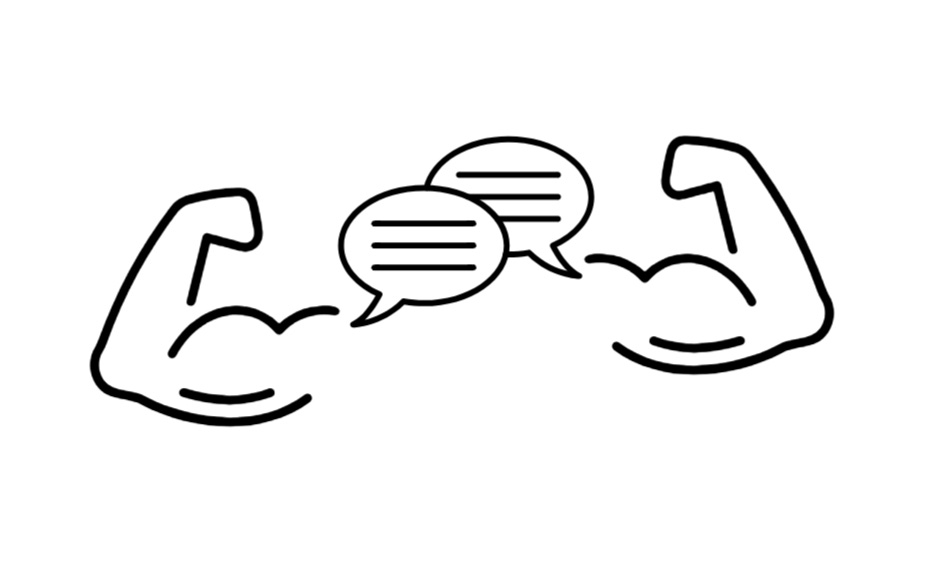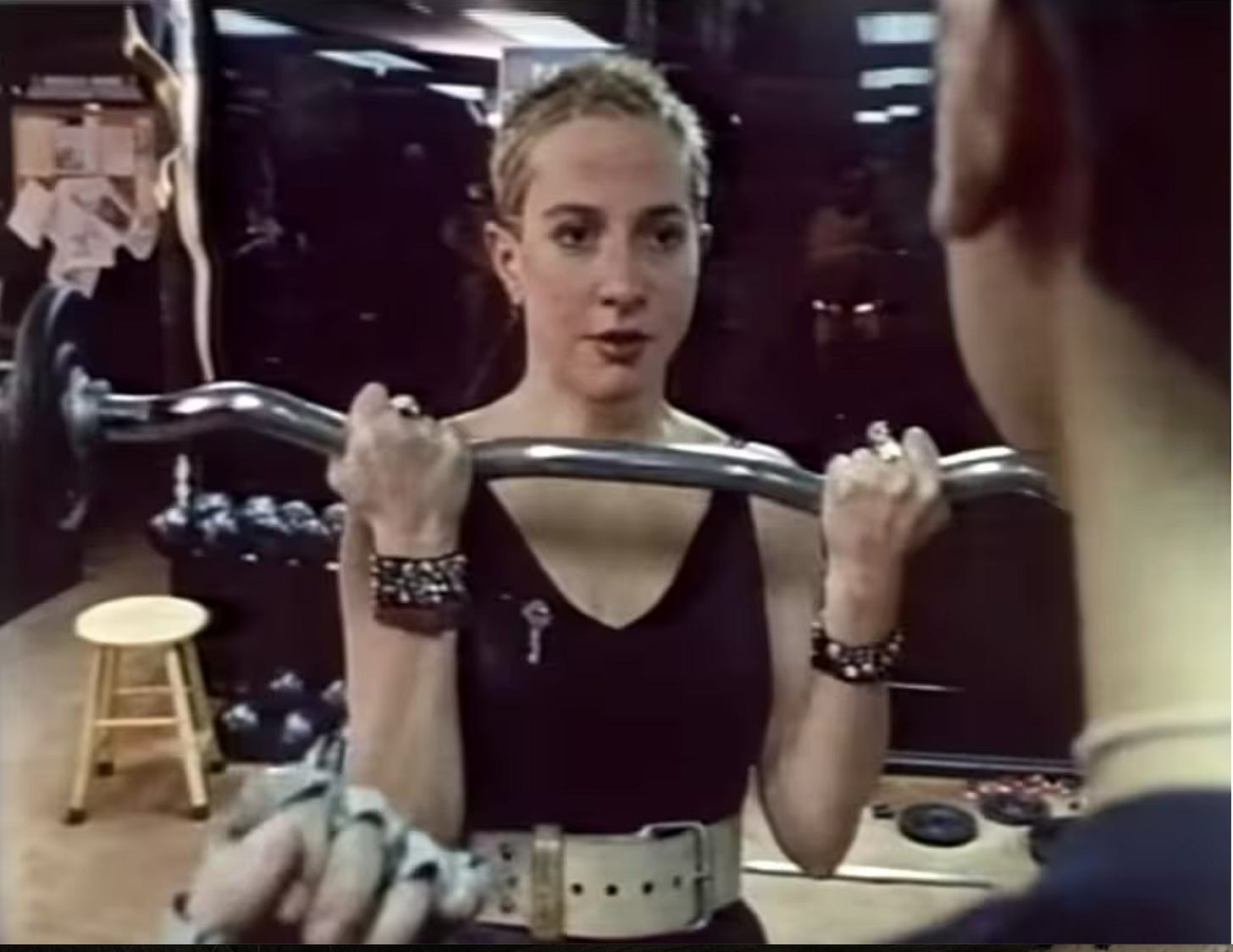Body language is a nonverbal form of communication, which conveys a lot of emotional and physical phenomena that spoken words can’t. Body language includes facial expressions, body posture, gestures, eye movement, touch and the use of space. These aspects are also important in works of visual art.
Kathy Acker was a visual and literary artist whose work poetically and graphically explores the lexicon of the human body. Acker’s own figure became an iconic representation of post-punk art, and as a muse for the photographer Robert Mapplethorpe.
As an artist and art historian, I’ve been aware of her work for a while. Now as a fitness trainer, I’ve returned to it with a greater fascination. Few artists have been able to express the liberating sensation of the body/mind connection more than Acker. In fact, she developed her conceptual art in tandem with literally sculpting, shaping and artfully utilizing her body. She got piercings and tattoos in intimate places, had a career as a sex worker and built toned muscle through a committed strength training routine.
Being that her body was raw material for her art, Acker addressed the crux of bodily autonomy and physical communication, revealing that, “I'm looking for what might be called a body language. One thing I do is stick a vibrator up my cunt and start writing – writing from the point of orgasm.”
And while she understood that her persona and physique was an influence on others, especially in punk and postmodern art scenes; Acker embraced flux and spontaneity to create a narrative that was liberally aware of corporeal issues. She reflected that, "After a certain age in America, particularly if you are not part of a recognizable couple, whether lesbian or straight, women become invisible. I found there was no need any longer to conform to anybody else's idea of how I should look."
She managed to control of almost every aspect of her bodily identity and narrative, including not seeking conventional medical treatment for cancer (thereby dictating how she lived and died on her own terms).
The ideology of bodily autonomy is a key component to social justice and reform. Our bodies are one of the most potent means for resisting and rebelling against the oppressive status quo, which is (in many civilizations) inherently chauvinistic, transphobic and ableist. This is evident through a number of countercultural and resistance activists who put their bodies on the front lines while advocating for transformative change (i.e. ACT UP and the Disability Arts Movements in the USA and UK).
Similar to her writing methodology, Acker’s weightlifting practice was a rebellious representation of the human body, which eschewed the mainstream lens of patriarchal culture. She embraced it in terms of taking full self control of her identity, and nurturing the symbiotic mind and body connection. Acker explained that strength training was her desired way to relax and take a break from writing, noting that “a friend of mine said only in New York do you relax by weightlifting.”
Bodybuilding is also a poetic language within Acker’s lexicon. Each muscle became symbolic of a grammatical inflection; and like words, they can be considered within a spectrum and used to add a variety of meaning, tone, emphasis and emotion to one’s personal identity. She describes this as “enlarging the range of possibilities” of the overall human experience within the world. “There’s no way you can do this and not have it change your life,” Acker asserts.
As I’ve delved into fitness, the parallels it has with art and education become apparent. I wholeheartedly understand what Acker describes when she writes that, “Meaning approaches breath as I bodybuild, as I begin to move through the body’s labyrinths, to meet, if only for a second, that which my consciousness ordinarily cannot see.”
Creating art is about self and collective discovery, presentation and communication. It’s a process centered around building a world from within for those on the outside to engage with. In art education, we prompt our students to learn form, technique and the affordance of materials. After they’ve developed an affinity for these foundational things, they’re encouraged to utilize them in a highly personal manner.
The same is true with exercise and strength training. Developing proper form and a committed routine enables us to progress into more challenging and expressive movements; while also giving us ample options to sculpt our bodies in accordance with a personalized aesthetic plan.
All of these endeavors are reliant on steady repetition, as well as the ability to harness the subconscious and make implicit feelings, imagery and ideas explicit.
Being disciplined, intentional and focused are all skills that the arts, education and fitness teach. Having a mindful attitude towards embodied learning is a means for incredible self-transformation. It ensures that we’re flexible, patient, compassionate and resourceful. This process ebbs and flows in response to internal and external stimuli. Acker notes, “For though I am only repeating certain gestures during certain time spans, my body, being material, is never the same; my body is controlled by change and by chance.”
Flexible purposing (a pedagogical methodology) means that we are adaptive to the unknown, and have a number of tools and frameworks that can help us to logically and creatively respond when confronted with foreseen or unforeseen circumstances. It’s one of our best methods for taking control over what we can from typically uncontrollable scenarios.
Governments and social influencers have taken actions that negatively shape the discourse on bodily identity; and they’ve succeeded in stifling and erasing individuals because of bias and ignorant perspectives around body politics. The absolute truth of the matter, however, is that the narrative and corporeality of our bodies is ours to control. While the topic of body autonomy is fraught and bleak in many contemporary societies, we have the resources and intuition needed to bring on change, and shift the power dynamics.
An educated and empowered populace is the antidote to being indoctrinated into a world of rote systems and regulations that favor a small, yet powerful class of people. Those of us in education have witnessed how it cultivates a love of learning, and a desire to engage with the world and its many complex nuances.
Thanks for reading Artfully Exercising!
Show me some ❤️
I’d be grateful if you’d take a moment to hit the “heart icon” on this post to show your appreciation (and boost this post within the algorithmic sea that is social media).
Consider subscribing 📩
Artfully Exercising is a reader-supported publication about art and fitness. To receive new posts and support my work, consider becoming a free or paid subscriber:
Documenting my physical and mental health journey in the form of Artfully Exercising has been a labor of love, which takes a lot of (well spent) time, energy and resources to write the content you receive in your email boxes. If my writing has given you any sort of inspiration and enrichment, please consider making a contribution by becoming a paid subscriber or making a one time contribution.
If you are not ready to become a paid subscriber, you can support my work with a one pledge at a monetary value of your choice:
Let’s continue the conversation 💬
If what I’ve written resonates with you, and/or you want to share your thoughts, please leave me a comment! One of the most rewarding things about writing is getting feedback and making connections with others!





